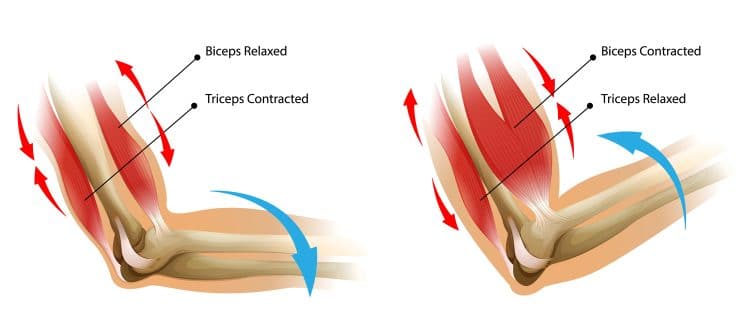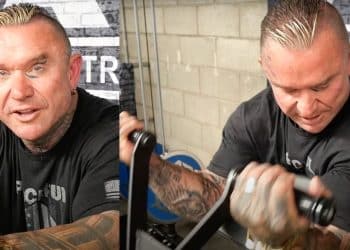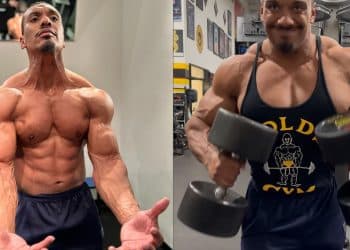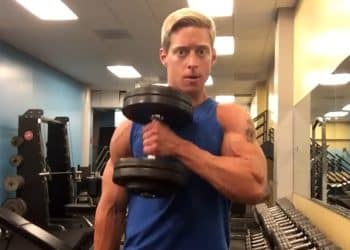It’s one of bodybuilding’s ironies that the biceps are one of the smaller muscles of the human body but also one of the most important. After all, there isn’t a bodybuilder alive who doesn’t want bigger, stronger, more muscular, FREAKIER biceps!
The biceps aren’t even the biggest arm muscle. That title goes to the triceps.
Regardless of this, bodybuilders the world over spend inordinate amounts of time and energy training their biceps. Most even dedicate entire training sessions to just their arms.
And yet, despite all this effort, a lot of lifters are dissatisfied with their biceps development. Set after set of barbell and dumbbell curls fail to produce the expected level of growth.
It’s very frustrating!
One of the reasons your biceps aren’t growing could be that your muscles are accustomed to your workouts. Muscles grow when they’re exposed to unique forms of stress, and doing the same exercises over and over won’t trigger hypertrophy.
Level Up Your Fitness: Join our 💪 strong community in Fitness Volt Newsletter. Get daily inspiration, expert-backed workouts, nutrition tips, the latest in strength sports, and the support you need to reach your goals. Subscribe for free!
That’s why smart bodybuilders change their workouts every 4-8 weeks and use a wide variety of exercises to avoid training boredom and progress plateaus.
If your biceps growth has ground to a halt, maybe it’s time to ditch the standard barbell and dumbbell curls and try something new.
In this article, we take a look at the Bayesian cable curl, explaining why and how to do it and the other equally effective exercises you can do instead.
Bayesian Curl – Muscles Worked
Like most curling movements, Bayesian curls are an isolation exercise which means they involve action at one joint only. Single joint exercises also tend to involve relatively few muscles.
The main muscles worked during Bayesian curls are:
Biceps brachii – this is the target muscle of Bayesian curls, more properly called the agonist. The biceps brachii is located on the front of your upper arm. It has three functions: elbow flexion, forearm supination, and shoulder flexion.
Biceps brachii means two-headed arm muscle, but it’s more usual just to call it the biceps. As such, the biceps have a long head and a short head, which come together to form a single attachment site on the forearm.
Brachioradialis – located on the thumb-side of the upper forearm, the brachioradialis works with the biceps to flex the elbow. It’s technically a forearm muscle but is strongly involved in Bayesian curls. Well-developed brachioradialis muscles link your upper arm to your lower arm and adds thickness to your forearm.
Brachialis – located beneath your biceps, the small but powerful brachialis muscle is your strongest elbow flexor. It works with your biceps to bend your elbow joint. As well as being very strong, this muscle helps to “prop up” your biceps and makes it look bigger. Bayesian curls place a lot of tension on this important muscle.
Forearms – there are lots of muscles that make up the forearms. The flexor group bends your wrist while the extensors straighten it. Both sets of muscles are involved in Bayesian curls, making this exercise good for building your upper and lower arms.
How to Do Bayesian Curls
Get more from Bayesian curls while keeping your risk of injury to a minimum by following these step-by-step instructions:
- Attach a D-shaped handle to a low pulley machine.
- Then, with your back to the pulley, grab the handle with one hand and step forward into a split stance for balance.
- Your palm should be facing forward, with your arm extended slightly behind you.
- Brace your core and pull your shoulders down and back.
- Without twisting your shoulders or hips, or using your legs or lower back, bend your arm and curl the handle forward and up to around shoulder height.
- Extend your arm down and back, and then repeat.
- Do the same number of reps on each arm.
Bayesian Curl Benefits and Drawbacks
Not sure if Bayesian curls deserve a place in your workout? Consider these benefits and then decide!
A full range of motion – the biceps are a biaxial muscle, meaning they cross and affect your elbow AND your shoulder joint. As such, with your arm extended behind you, Bayesian curls start with your biceps in a stretched position. This means Bayesian curls work your biceps through their full range of motion, making them unique and extremely effective for triggering muscle growth.
Constant muscle tension – your biceps are under continuous tension during Bayesian curls; there is no drop off at the top or bottom of each rep, as there often is in freeweight biceps exercises. Constant tension creates more hypoxia and metabolic stress, which are triggers of muscle growth. They also deliver a great pump.
Identify and fix left-to-right imbalances – Bayesian curls are a unilateral or one-sided exercise. Training each arm independently means you’ll be able to spot and fix imbalances, ensuring that your arms are equally well developed.
A stronger mind-muscle connection – Bayesian curls are a very strict exercise and, as you’ve only got to think about one arm at a time, will reinforce your mind-muscle connection. Putting your entire mental focus on one muscle produces better results than an exercise you cannot really feel working.
A low-risk exercise – cable exercises are often safer than their freeweight alternatives. The weight is guided on rods, so you don’t have to worry so much about balancing or stabilizing the load.
Bayesian curls are also very joint-friendly, so they are less likely to cause elbow pain than other types of curls. That said, you DO need reasonably good shoulder flexibility to do this exercise correctly.
While Bayesian curls are a mostly beneficial exercise, there are also a couple of drawbacks to consider:
Level Up Your Fitness: Join our 💪 strong community in Fitness Volt Newsletter. Get daily inspiration, expert-backed workouts, nutrition tips, the latest in strength sports, and the support you need to reach your goals. Subscribe for free!
Shoulder stress – Bayesian curls involve extending your arm behind you. This position puts some stress on the shoulder joint. If you have very tight shoulders or are currently suffering from shoulder pain, Bayesian curls may be uncomfortable.
That said, you can mitigate this problem by staying close to the cable machine and limiting how far you extend your arm behind you.
Not practical for heavy weights – while Bayesian curls are an excellent bodybuilding exercise, they’re less useful for serious strength training. If you use very big weights, you may find yourself being pulled off balance or twisting your hips or shoulders.
As such, this exercise is best done using light to moderate weights and for medium to high reps. However, it’s not really practical for low rep/heavy strength training.
Time-consuming – unilateral exercises take longer to perform than bilateral (two-limbed) exercises. If your time is limited, you may find that doing Bayesian curls takes longer than, for example, barbell or two-handed cable curls.
7 Best Bayesian Curl Variations and Alternatives
Bayesian curls are a highly effective biceps exercise, but that doesn’t mean you need to do them all the time. There are several variations and alternatives you can use to keep your workouts productive and interesting:
1. Bayesian hammer curls
Bayesian curls are usually done with a supinated or palms-up grip. However, that doesn’t mean you can’t position your hands differently to add even more variety to this excellent exercise. Bayesian hammer curls still work your biceps but also emphasize your brachioradialis and brachialis muscles.
How to do it:
- Attach a single rope handle to a low pulley machine.
- With your back to the pulley, grab the handle with one hand and step forward into a split stance for balance.
- Your arm should be extended slightly behind you, and your palm should be turned inward to face your leg.
- Brace your core and pull your shoulders down and back.
- Without twisting your shoulders or hips, or using your legs or lower back, curl the handle forward and up to around shoulder height. Do not rotate your wrist.
- Extend your arm down and back, and then repeat.
- Do the same number of reps on each arm.
2. Double Bayesian curl
If you are lucky enough to have access to a twin low cable machine, you can train both arms at the same time with double Bayesian curls. Perform the exercise as usual but hold a handle in each hand. However, for the sake of balance, make sure you swap your feet around set by set and don’t always lead with the same leg.
3. Resistance band Bayesian curls
No cable machine? No problem! You can do Bayesian curls using a resistance band. This exercise is ideal for home lifters and anyone without access to a dedicated low cable station.
How to do it:
- Attach the end of your resistance band to a low anchor point, e.g., the bottom of a power rack.
- With your back to the anchor, grab the other end of the band with one hand and step forward into a split stance for balance.
- Your arm should be extended slightly behind you, and your palm should be turned inward and facing your leg.
- Brace your core and pull your shoulders down and back.
- Without twisting your shoulders or hips, or using your legs or lower back, curl your hand forward and up to around shoulder height.
- Extend your arm down and back, and then repeat.
4. Incline dumbbell curls
Incline dumbbell curls are basically a freeweight version of Bayesian curls. Using an incline bench puts your arms in an extended position at the start of each rep. While muscle tension does start to drop off at the top of each rep, this is still a decent alternative to Bayesian cable curls.
How to do it:
- Set the backrest on your exercise bench to around 45-degrees.
- Sit on the bench and lean against the backrest. Let your arms hang down and back. Plant your feet firmly on the floor. Pull your shoulders down and back.
- Bend your elbows and curl the weights forward and up until your forearms are slightly above parallel to the ground.
- Lower the weights down and back and repeat.
5. Drag curl
Drag curls were a favorite exercise of legendary bodybuilding coach Vince “the Iron Guru” Gironda. With this exercise, you pull your elbows back as you curl the weight up, which a) stops you from using your deltoids to raise the weight and b) keeps your biceps under more constant tension.
While it’s not an exact freeweight copy of Bayesian curls, it’s similar enough to be considered an good alternative.
How to do it:
- Hold a regular or EZ bar with a shoulder-width, underhand grip. You can also use dumbbells, a cable, or even resistance bands. Stand with your feet shoulder-width apart, brace your core, and pull your shoulders down and back.
- Pull your elbows back, bend your elbows, and drag the barbell up the front of your body to your lower chest. It should remain in constant contact with your torso.
- Lower the bar back to the starting position and repeat.
6. Supine cable curls
One of the great things about Bayesian curls is that they make it much harder to cheat the weight up. Your stance and arm position mean you can’t really use your legs or back for help. The supine cable curl don’t put your arms into an extended position, but it will stop you from cheating!
How to do it:
- Attach a straight bar, EZ bar, or rope handle to a low pulley.
- Sit on the floor with your legs straight and grab your chosen handle.
- Lie back, so your head and shoulders are resting on the floor.
- Pull your upper arms into your sides.
- Bend your elbows and curl the handle up to your shoulders.
- Extend your arms and repeat.
7. Dumbbell concentration curls
Bayesian curls are a very effective biceps exercise. Starting from a stretched position, they keep your biceps under near-constant tension, which can help build muscle faster than other types of curls.
That said, according to science (1), the concentration curl is THE best exercise for fully engaging biceps muscle fibers, so it’s only fitting that we include it on our list of Bayesian curl alternatives!
How to do it:
- Sit on an exercise bench with a dumbbell in one hand.
- Lean forward and place your upper arm against the inside of your thigh. Let the weight hang down toward the floor.
- Keeping your arm against your inner thigh, bend your elbow and curl the weight up to your shoulder.
- Lower the arm and repeat for the desired number of reps.
- Switch arms and to the same number of reps on the other side.
Bayesian Curls – Wrapping Up
While there is nothing wrong with barbell and dumbbell curls, you CAN have too much of a good thing. That’s why, if you are serious about building awesome arms, you need to use a variety of exercises in your biceps workouts.
Use preacher curls, hammer curls, spider curls, cable curls, and now Bayesian curls to hit your biceps from every available angle and keep your muscles growing.
That’s not to say than Bayesian curls are better than any other biceps exercise. It’s just that they are different. And when it comes to building muscle and staying out of training ruts, those differences really matter.
So, add Bayesian curls to your next biceps workout – your muscles will thank you!
References:
1 – American Council on Exercise: ACE Study Reveals Best Biceps Exercises https://www.acefitness.org
Interested in measuring your progress? Check out our strength standards for Incline Dumbbell Curl, Dumbbell Curl, Dumbbell Concentration Curl, and more.












